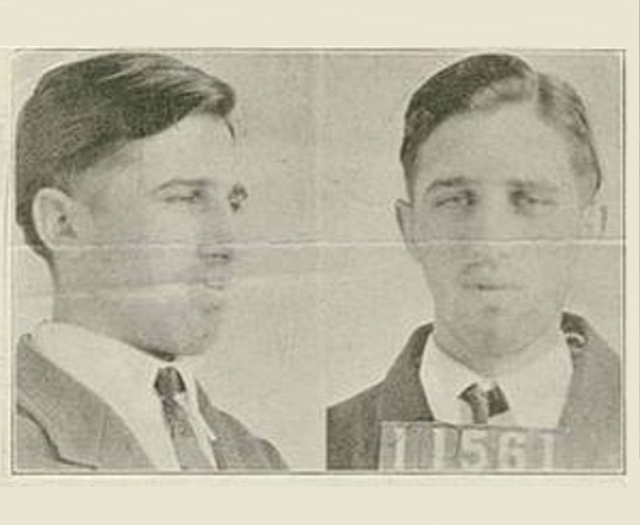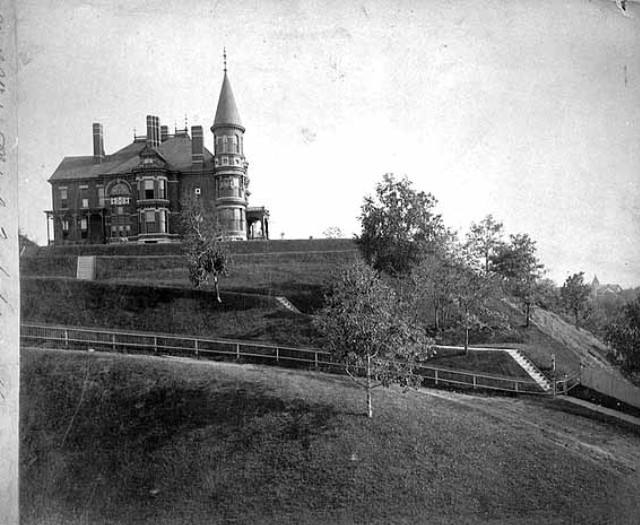After a long day at work at St. Paul's Municipal Airport, McCord rushed over to help his friend Cowin investigate suspicious activity near Cowin's apartment in the early morning hours of January 13, 1934. After arriving, a three-person "posse" of McCord, co-worker Robert Luening, and Cowin began looking around. McCord was armed with a small caliber pistol and a pair of brass knuckles.
Concerned about potential “peeping toms,” McCord's wife had called him at work and asked him to help search. When his shift ended, McCord enlisted his co-worker and rushed over to Cowin’s apartment on 562 Holly Ave. Soon after, the three men began patrolling the area, with McCord still wearing his work uniform.
Across the alley, members of the notorious Barker-Karpis gang were meeting on the second floor of Myrtle Eaton's apartment at 565 Portland Ave. They were planning the kidnapping of Commercial State Bank president Edward Bremer - one of many such meetings held over the preceding weeks. Gangsters Alvin Karpis and Fred Barker noticed a figure peering through the windows of a nearby apartment. Barker went outside to investigate and spotted a man standing on the corner.
Fearing the authorities were onto them, he quickly relayed his findings to the others. The gang decided to end the meeting and reconvene elsewhere. Working in pairs, they managed to slip away undetected.
The group was in the clear but couldn’t get past their close-call run-in with the police. The Bremer kidnapping was a risky undertaking, but if local law enforcement had discovered their plan, their odds of success were next to none. The gang had to be sure. Karpis and Barker armed themselves and drove back into the neighborhood they'd recently escaped to investigate.
As Barker drove a Chevy sedan around surrounding streets, he and Karpis noticed a dark car slow down to look at them on St. Albans between Portland and Holly avenues. It was McCord and his passengers. The neighborhood was very close-knit, and the Chevy the three men found themselves in front of was unfamiliar.
McCord's "posse," armed with a pistol and brass knuckles, soon learned they were dealing with something far more serious than simple prowlers. In a terrifying blitz, the gangsters leaped from their car. They unleashed a hail of bullets, emptying their clips into McCord's Ford, the vehicle absorbing nearly fifty rounds. McCord himself was hit up to six times.
The two gangsters then drove away.
Injured but alive, McCord walked himself into St. Joseph's hospital. Three bullets dropped to the floor as hospital staff undressed him. Doctors removed the others. Fortunately, Cowin was only slightly wounded and Luening had escaped uninjured. The harrowing experience shook them both. After an extended hospital stay, several surgeries, and rehabilitation, McCord lived to tell the tale.
Barker and Karpis learned the next day that they made a serious mistake. The gangsters had seen a dark-colored car with men in uniform and thought they were law enforcement. Unfortunately, McCord's dispatcher uniform, with its peaked hat and dark jacket with brass buttons, had made him look like a police officer.
Roy McCord’s near-fatal run-in sowed seeds of outrage citywide. Local citizens now called for the end of the gangster menace by any means necessary. The St. Paul Daily News and its editor, Howard Kahn, took the fight directly to corrupt city officials. They questioned the validity of city laws that seemed to protect criminals and whether the current regime was working in citizens' best interests or merely lining their own pockets.
McCord's story resonated deeply - a hard-working family man, sole provider, gravely injured while trying to protect his loved ones. He became a symbol of the city's outrage against rampant gangster activity. His plight exposed the vulnerability of ordinary citizens. For years, those tasked with protecting them had seemed, if they weren't directly involved in corrupt acts, to look the other way.
The uproar briefly made St. Paul “too hot” and gave the gang pause. They even discussed postponing the Bremer kidnapping. However, their concern didn't last long. On January 17, just four days after the shooting of Roy McCord, members of the Barker-Karpis Gang abducted Bremer from his Lincoln on the corner of Goodrich and Lexington shortly after dropping his daughter off at school.
That same day, the St. Paul Daily News announced its crusade against organized crime with the article, "Who Shot Roy McCord?" It took time before it ended officially, but St. Paul’s gangster era – and the corruption that enabled it – was coming to a close.
This location is a stop on the:
St. Paul Gangster Tour
Published: October 21, 2023
Bibliography
- Frethem, Deborah, and Cynthia S. Smith. Alvin Karpis and the Barker Gang in Minnesota. Charleston: Arcadia Publishing, 2020.
- Maccabee, Paul. John Dillinger Slept Here: A Crooks' Tour of Crime and Corruption in St. Paul, 1920-1936. Minnesota, 1995.
- Madera Tribune (Madera County). "Kidnaping And Crime In St. Paul Charged Result Police Graft." February 5, 1934, 1.
- Mahoney, Timothy R. Secret Partners: Big Tom Brown and the Barker Gang. Minnesota Historical Society Press, 2013.
- Minneapolis Star Tribune. "Shooting Victim's Condition Critical." January 15, 1934, 8.
- Winona Republican-Herald. "Doctors and Nurse Demand $50.000 Bonds be Reduced." April 19, 1934, 1, 5.


